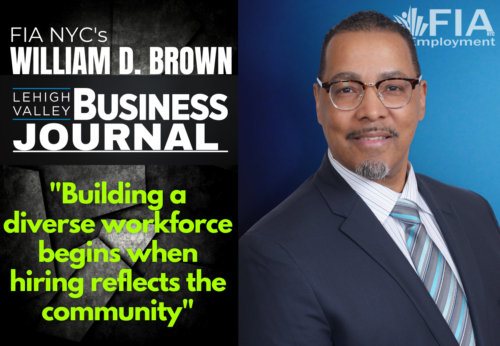
By: Melinda Rizzo, Contributing Writer
November 25, 2020 12:25 pm Who doesn’t want to grow their businesses? Meaningful workplace diversity, where positions at all levels of an organization represent the melting pot of American culture and life, could, in fact, ultimately add to a business’s bottom line.
…William D. Brown, co-founder, CEO and director of Diversity Equity and Inclusion at FIA NYC, LLC, in Allentown, doesn’t believe Lehigh Valley employers or human resources professionals are intentionally being discriminatory or racist in their hiring practices. Rather it’s often about being pragmatic.
“I’ve learned a lot of what is perceived as racism is bigotry, and it is really not intentional,” Brown said.
He said people prefer to work with those who are – and look, like them.
The perception of being or working with others who come from the same place, are the same race or culture, and would therefore share common values is a long-standing starting point.
“People who are like me are [actually] the opposite of diversity,” Brown said.
“People like me” thinking further translates into having shared interests or shared political views.
He said diverse teams – or those made up from a variety of cultures, genders, gender identities and age or generational groups are roughly 87 percent better decision makers than those who are not.
And groups including age or generational gaps of at least 20 years will make “much better business decision makers.”
Embracing a diverse workforce can have added positive effects as the business mindset organically widens and stretches opportunities to sell or market products and services beyond a single demographic.
“Bring in more diverse ideas and cultures and you have a bigger audience,” Brown said.
To be enduring and sustainable diversity hiring must be genuine and authentic rather than legal checking boxes or filling mandated quotas. “If you bring someone in who feels different or like a quota, they are not going to stay,” he said.
Becoming authentic requires getting inside the company culture with a desire to expand it, Brown said. Getting to know various people by learning about them, and sharing experiences with their culture and beliefs helps to move us beyond limiting stereotypes.
“If you don’t have that you’re never get anywhere,” Brown said.
Changing the company’s culture starts at the top by increasing diversity among decision makers. Creating strategies to sustain talent and positively integrate everyone into the work culture gives employees a reason to contribute and stay with an organization over the long haul.
“Seek yourself in the culture and be in the culture enough to understand the people,” he said.
